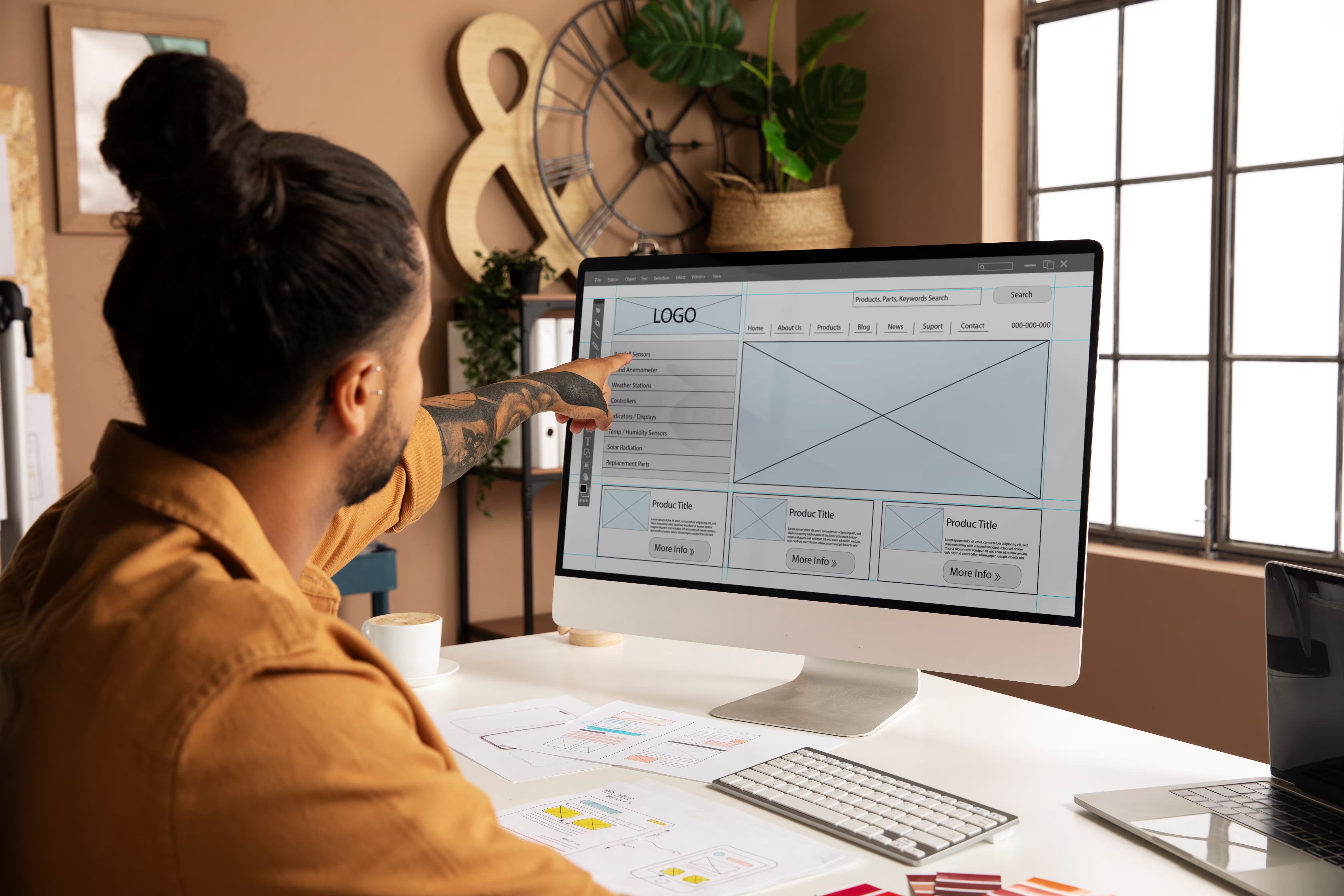The ultimate goal of any website is for the visitor to do something. To achieve that, it’s crucial that you optimize your Webflow website for conversions. Stick around and learn how to turn your site visitors into paying customers with a few simple tricks.


The purpose of your Webflow website
Before getting started, you need to ask yourself what’s the purpose of your website? Most sites are designed and built so the visitor has to engage to get something in return - like leaving an email, downloading a resource or buying your product. If they end up doing that, it means they converted.
So to get as many visitors as possible to convert, you need to know exactly what you want from them. But there are so many factors influencing the conversion rate that it can be overwhelming to figure out where to start. Whether you’re looking to boost your sales, grow your email list or just drive more traffic to one of your resources, these tips will help you optimize your website for the best results possible.
Understanding the problem your visitors have
Not a single website is perfect for everyone. Every person has a different interest and a reason why they ended up on your website. It’s important that you understand your users so you can talk to them and give them more reasons to convert. Some of the questions you should ask yourself are what are their needs, what are their goals and what are they looking for when they come to your site?
Once you understand who your users are, you can start looking into the problems they might have on your website:
- Low conversion rate: It means the visitor doesn’t do anything you want them to on your website (like fill out a form, click a button or download content). It might be because your site is not optimized or you’re not bringing enough value.
- High bounce rate: It means the visitor leaves your website fast, not showing any particular interest. It might be because your site is not relevant, the content is not engaging enough or there might be other issues like slow loading.
- Navigation issues: It means the visitor has trouble navigating around your site. It can be because of bad design or just some parts of the website are harder to find.
- Session duration: It means the time spent on a website. If the visitors don’t spend much time on your site, it might be because the content is irrelevant, they face a problem and leave or they can’t find what they’re looking for.
When you identify exactly what’s preventing your site visitors from converting, you’ll be able to test different variations and improve the conversion rates on your website.
Some of the most common ways of testing what your users are doing are:
- A/B testing: It means showing different website variations to different segments, seeing which one performs better.
- Heat mapping: It shows visual representation of your website, mapping out where the visitors spend the most time and what’s being clicked on.
- Flow analysis: It follows the visitor from entry point on your website to conversion (if it happens), showing all the steps it takes for someone to make a purchase, download something or leave an email.
All that can be super helpful when it comes to optimizing your Webflow website, but it’s important that you keep on testing what works and what doesn’t.
Top 10 tips to improve conversions on your Webflow website
By following the tips in this article, you'll be able to improve your conversions, decrease the bounce rate and keep your site visitors engaged for a longer time. All that leads to more revenue for you.
1. Straight-to-the-point headline
The majority of site visitors only skim through the headline, so it’s even more important that it catches their attention. Your headline should be straight to the point, clear and concise. Here are some tips to improve your headline and keep the visitors engaged:
- Communicate your message quickly: Your site visitors will make snap judgments about whether or not to stay on your website based on what the headline communicates. If it’s not clear and tells them what to expect from you, they’ll leave and never return.
- Value proposition: A great headline can differentiate you from your competitors. It should tell the unique value of your services or products, encouraging the visitor to stay and buy from you.
- Keep it short: Too long or too complex headlines will make visitors lose interest. Short copy on the other hand increases readability and makes it easier for visitors to understand your message.
- Don’t forget about SEO: Your headline should be relevant to the content on your website, but don’t neglect the search engines if you want to rank well. It’s important that you do keyword research and add appropriate keywords in your headline.

2. Clear copy
Your landing page copy should be short and actionable. Get straight to the point and tell the visitors exactly what they will get from you or your products. If they have a hard time figuring out what the site is all about, that’s a big no-no when it comes to conversions. You need to offer your audience something they really want and you need to be very clear about it.
3. Offer enough value
Your site visitors are looking for the promise of real value, so if you give them enough they’ll eventually convert. For some that’s added benefits and perks, for others it’s discounts and for some the trust and guarantee is the most important. Once you know what your site visitors are looking for, it’s easy to offer them personalized content and provide real value.
Some ways to do that:
- Leverage early access, discounts or limited-time deals to get more sign-ups (make sure to group these early users separately so you can offer them personalized content later).
- Keep your site visitors engaged by offering valuable tips or resources for free (they’ll get to know your brand better and start trusting you).
- Produce ebooks or checklists that help your audience solve a specific problem (you can let them know you’re there if they can’t do it themselves).

4. Easy navigation
Navigation is important, but keep in mind that it has to be simple. If your site visitors get lost or they can’t find what they’re looking for, all your effort goes to waste.
Here are some recommendations for your website navigation:
- The most important information should be on top of the page.
- Page structure should be similar across the whole site.
- Keep things clear and straight to the point.
- If it gets cluttered, help yourself with icons and dropdown menus.
- Information should be reached as soon as possible (max 1-2 clicks).
5. Call to action
Call to action or CTA is a part of your website that makes your visitors take action. Usually it’s a button or a form that lets people engage and connect with you or even buy from you. It’s important that the CTA process takes as few steps as possible. Don’t make it complicated because nobody’s going to get in touch with you if they have to spend a lot of time doing that.
Your call to action should clearly communicate exactly what happens once the site visitors engage. For example if you want someone to jump on a call with you, a simple “Book an intro call” or “Schedule a call” would do. But it really comes down to what you want and what you’re offering them. If you just place a random button saying “Buy now!” without context, that’ll turn people off and they won’t buy. It’s shady.
A common practice (especially for bigger landing pages) are also two CTAs, one placed around the headline (on the first section of your site - the one that’s instantly visible to the visitor) and another one around the footer when they scroll down. But make sure that you position them strategically and with context, because misplaced CTAs usually increase the bounce rate.

6. Page performance
No one likes slow sites and it’s the biggest turn off for visitors. It’s one of the most important basics you need to take care of, because that’s also one of the biggest reasons for increased bounce rates on the internet.
If your site performance is slow, search engines will mark it down and you won’t be able to rank. Thankfully, Webflow is built with speed in mind. It automatically takes care of optimizing your content, images and videos. But if you’re building a more complex site, relying just on Webflow’s default features won’t be enough. So make sure that you optimize the overall health of your website.

7. Responsive for mobile
More than 80% of people browse the internet from mobile devices. It would be a real shame if your website is only optimized for desktop, but not for other devices like smartphones or tablets. Webflow makes responsive development easy, so keep testing it and try to optimize your website for the best performance on all devices.
8. Social proof
Word-of-mouth is one of the most effective marketing strategies. By adding a testimonials section, you’ll build trust and encourage others to work with you. People generally trust people and when they see what others are saying about your business, they’ll more likely convert.
We use Clutch and Trustpilot to get reviews from our clients and display the reviews and ratings on multiple parts of our website. You would be surprised how just one review can change it all for your business.

9. Lead form
Having a lead form on your website is crucial, because some visitors might not want to convert without getting more information from you. At Flowout, we prompt everyone interested in unlimited Webflow design and development service to book a quick call (where you discuss the details, what you want, how compatible we are, etc.), but not everyone wants to do that right away. And that's okay.
So we added an option that you can watch a demo of how the whole workflow looks like. To start watching it, you just have to enter your name and email (so we can get in touch later).

10. Visual elements
A landing page with just blocks of text is unappealing and doesn’t stand out from the crowd. It’s nothing special and it doesn’t communicate well enough. By displaying informative (“explainer”) videos on your landing page, you can increase your conversion rate by a whooping 86%!
Do you know the saying “A picture is worth a thousand words?” - use it to your advantage because it works. Images on your website should be complementary to your offer.

Your conversions should improve
By following these tips and common practices for creating a high-converting Webflow website, you’ll hopefully optimize your site and increase conversions as soon as possible. However, optimization is an ongoing process and you need to constantly iterate things to see what really works - remember that every visitor is unique and has different needs and expectations.
Although Webflow’s powerful built-in features make it easier to optimize your website for conversions, it might be too much of a hassle or work for some of you.
That’s why we’re here, a team of Webflow experts. We’ll help you build and optimize your site from the ground up. Feel free to get in touch and we’ll discuss how we can help you. No contracts or surprises.




















